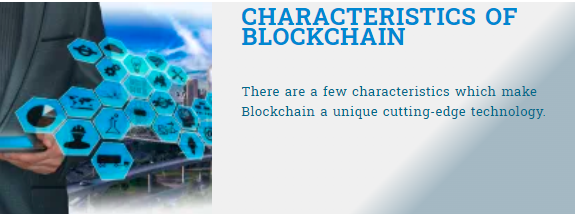Blockchain is usually known for the backbone technology of cryptocurrencies and there is a reason for that. Many of us diverted our intentions to learn about Blockchain when we heard the noise of cryptocurrencies around us. However, Blockchain is a lot more than just being a mechanism behind buzzword of bitcoin. The innovative solutions offered by frontline tech of Blockchain is transforming the ways we are accustomed to perform our business activities.
CHARACTERISTICS OF BLOCKCHAIN
Based on its basic mechanism, a typical blockchain solution shall have the following characteristics:
DE-CENTRALIZATION
The foremost important characteristic of a blockchain solution is its ability to provide decentralized record keeping mechanism. Maintaining records decentralized, instead, with a central authority reduces the risk of manipulation by the subject authority.
The copy of record for ownerships of any asset is retained on a block by each node/ device connected to the blockchain network. All these copies on a network are constantly being endorsed by each device on the network. Therefore, the copy with every device on a network is first hand, and will be considered original.
GROUP CONSCIOUSNESS
All the connected devices on a blockchain network continuously keep validating each other’s records. The version of a block, held by the majority is automatically retained and all other remaining variants are discarded.
As a result, any version of a record, agreed by a simple majority is considered the truth and accepted by whole network.
TRUSTLESS
In a traditional record keeping frameworks, ledgers, databases and records of ownership are maintained by a central authority. Whereas, on contrast, in the blockchain solutions no one needs to trust on any central Authority. The Blockchain process provides a safe, secure digital ledger and a record keeping mechanism, in which participant do not need to know or trust each other to make transaction.
Every transaction is endorsed and validated by the majority of the network’s participants. Moreover, each network owns the original copy of the record. All of the aforementioned features of recordkeeping in a blockchain solutions eliminate the need of users to trust a central authority to verify the authenticity of a record.
IMMUTABILITY
In blockchain technology each development/ announcement (e.g., transfer of ownership of underlying assets) is recorded on a block. When prescribed number of announcement/ transaction have been recorded on the block, another new block is created and all the contents of the previous block are converted to a code through hashing/ cryptographic technology. This code/ hashing is embedded in the header of the newly created block. This process creates a chain of blocks chained with each other through hashtags.
Changes in any previous block requires changes in embedded codes on all blocks after the modified block. This editing in hard coded hashtags of large number of following blocks, on majority of connected devices of a network, requires consumption of extensive computing power which needs significant time and energy.
Moreover, the frequency of creation for new blocks, in any blockchain solution is kept so high that it is always impossible to change the encrypted tags from all the following blocks and to hack majority of devices on a network at the same time. The more frequent new blocks are created, the less time a hacker will have to decrypt and hack majority of devices on the blockchain network. Thus, time constraint to hack a blockchain network adds a further layer of security against attacks on a blockchain network.
The above-described constraints of modification in records, makes it almost impossible to manipulate the database on a blockchain because the way blocks are chained and validated on a huge network of devices thus, making the blockchain an immutable digital ledger.
PUBLICLY VERIFIABLE
In a blockchain network, a firsthand version of record is kept by each participating device on the network. Thus, any record can be verified publicly, instead, being on the mercy of a centralized authority for seeking verification and authenticity of a record.
LOW TRANSACTION COST
A blockchain solution provides immutable, decentralized, trustless transaction experience and a transaction can be executed from any devices connected to a blockchain network. It means in order to execute a transaction, we do not need to use trust worthy intermediaries e.g., Banks etc to validate that transaction. This in turn will reduce the cost of carrying a transaction.
REDUCED TIME
Blockchain solutions ensure immutable, decentralized and trustless modes to maintain digital ledger and databases. This enables to transact and transfer records in between two connected devices on a blockchain network without endorsement of a central authority. The direct and secure way of date exchange, reduces the time of a transaction. Hence, the time a transaction may take on a blockchain solution will be much lessor then a traditional, even advanced banking method now a days may take.
GLOBAL TRANSACTIONAL CAPABILITY
In a blockchain network, devices can be connected from any part of the globe subject to the availability of a stable internet connection. This means, transactions can be executed and settled in real time directly in between devices from any part of the world, without involving intermediators and central banks of both countries.


